Japanese Clear Soup or Osumashi features a simple dashi-based broth lightly seasoned with soy sauce. With this elegant soup, you can easily switch up the colorful ingredients depending on what‘s in season. Here, I added kamaboko fish cake slices, mitsuba leaf, shiitake mushrooms, and flower-shaped fu (wheat gluten). The broth‘s deep, clean taste allows the seasonal flavors to shine through.
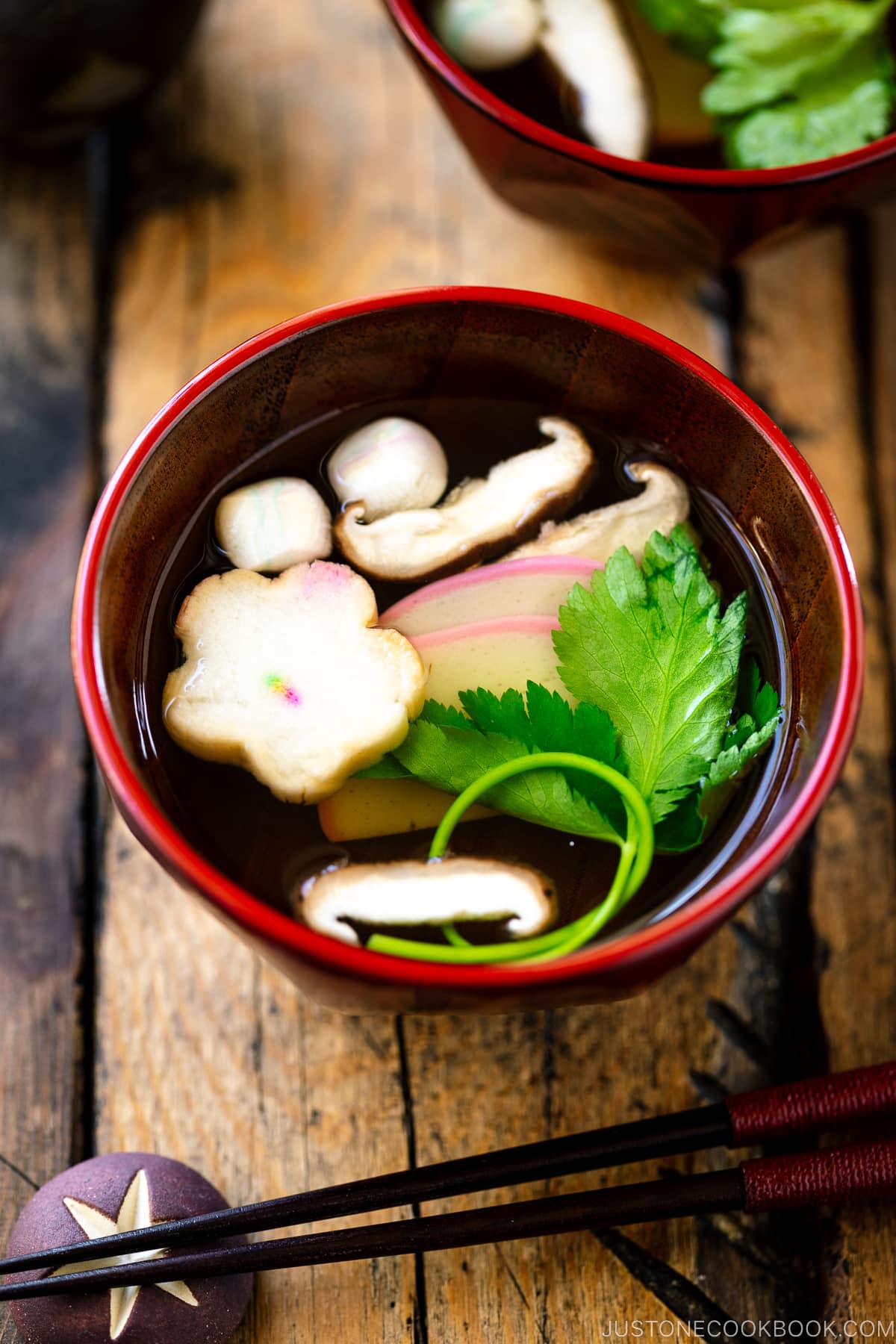
Besides the quintessential miso soup, the Japanese also enjoy various styles of soups. This Japanese Clear Soup called Osumashi (おすまし) is not only delicious, it is also effortlessly elegant and nourishing! The beauty of it lies in its simplicity. Because of the use of good dashi, the flavor of this soup is complex and 3-dimensional, and not bland at all. I hope you give it a try tonight!
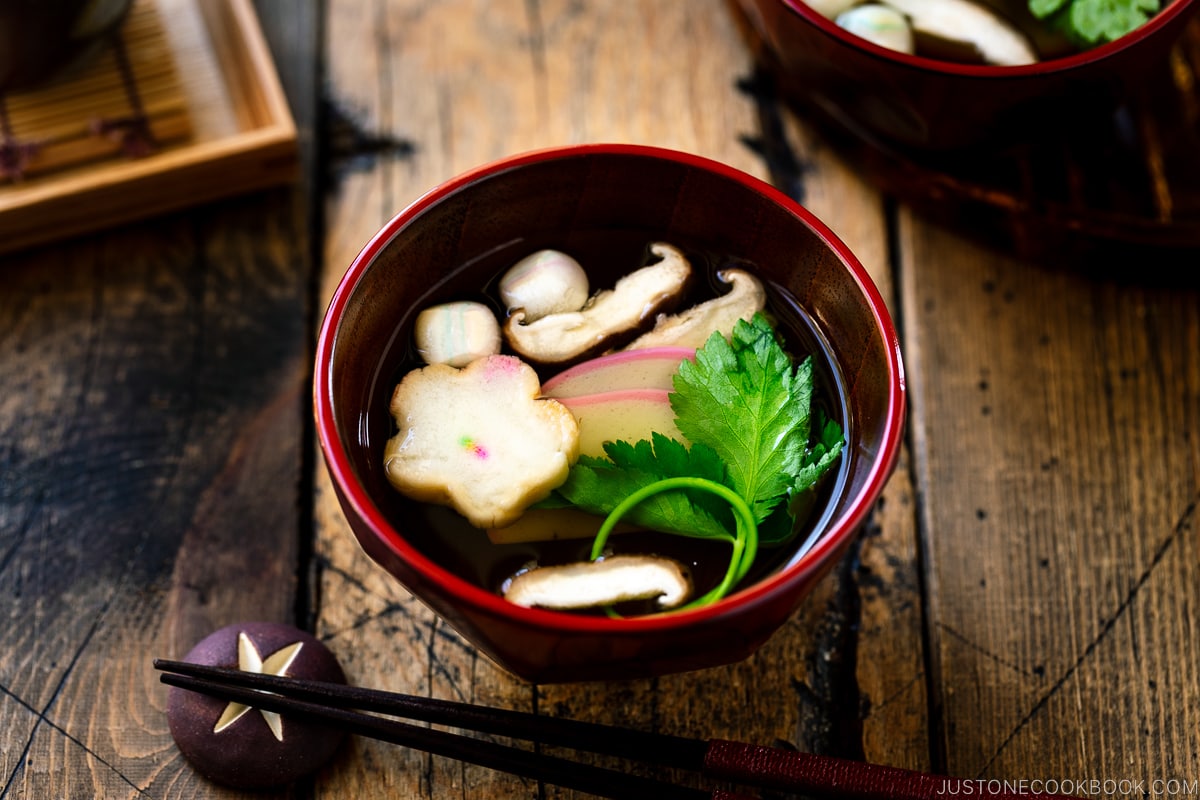
What is Japanese Clear Soup?
Japanese clear soup is called osumashi (Osumashi) or sumashi-jiru (sumashi soup) and it’s one of many types of Japanese soup (osuimonoSoup).
Now this is completely different from the so-called Japanese clear soup served at the hibachi grill restaurants or non-authentic Japanese restaurants in the US. I know that some people are thinking of “Japanese Onion Soup”—also known “Miyabi Soup” or “Hibachi Soup”—made by simmering beef broth or chicken broth and veggies such as carrots, celery, fresh ginger, and garlic. This soup commonly includes sliced mushrooms, scallions, sometimes tofu, and sesame oil. However, I’ve personally never heard of this soup in Japan as we don’t use beef broth at all! I believe this could just be another American mashup invention, mixing up all Asian flavors and calling it Japanese.
Unlike the clear soup served at the hibachi steakhouse, the characteristic of authentic Japanese clear soup is the use of really good dashi (Japanese soup stock) and seasonal ingredients. The dashi is lightly seasoned with salt and soy sauce. We typically use light-colored soy sauce so that the soup stays unclouded. The final taste is delicate, complex yet pure.
The big difference between miso soup and clear soup is that clear soup is often served on special occasions, such as Japanese New Year, Hinamatsuri (Girl’s Day), and all the seasonal festivals.
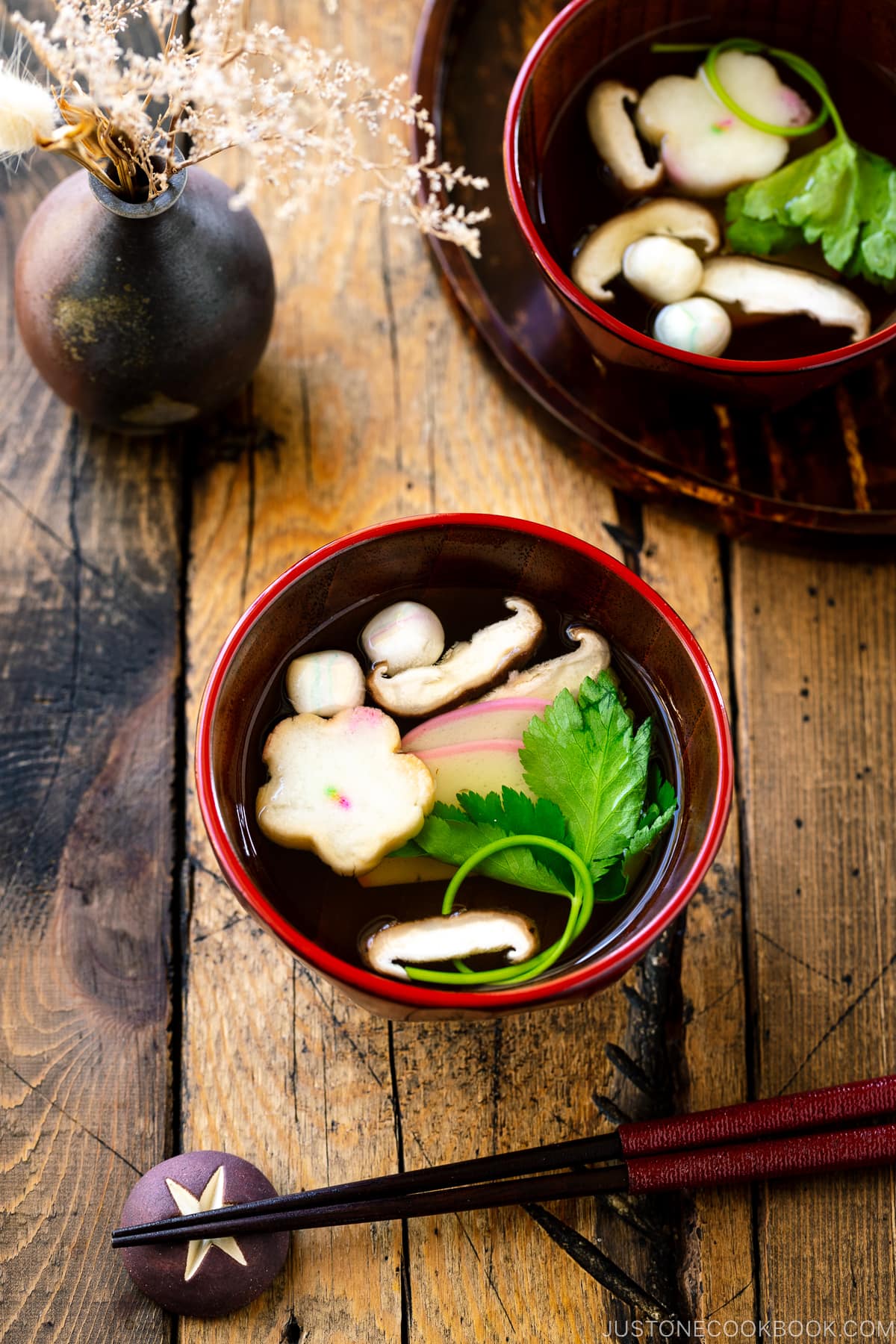
How to Make Osumashi
Ingredients You’ll Need
Overview: Cooking Steps
- Make the dashi from scratch. I used Awase Dashimade with a combination of kombu and katsuobushi. In a pinch, you can substitute a Dashi Packet or Dashi Powder. For vegan/vegetarianuse Vegan dashi.
- Add the seasonings and ingredients to the soup.
- Serve the soup.
Cooking Tips for Osumashi
- The soup stock is the most important component of this soup. Take time to make a really good dashi. If you’re new to Japanese soup stock, read this post. I don’t recommend using dashi powder. If you really want to take a shortcut, use a dashi packet.
- Use light-colored soy sauce. The salt content of light-colored soy sauce is slightly higher than regular soy sauce despite its name.
- Use seasonal ingredientsif possible. Please read below.
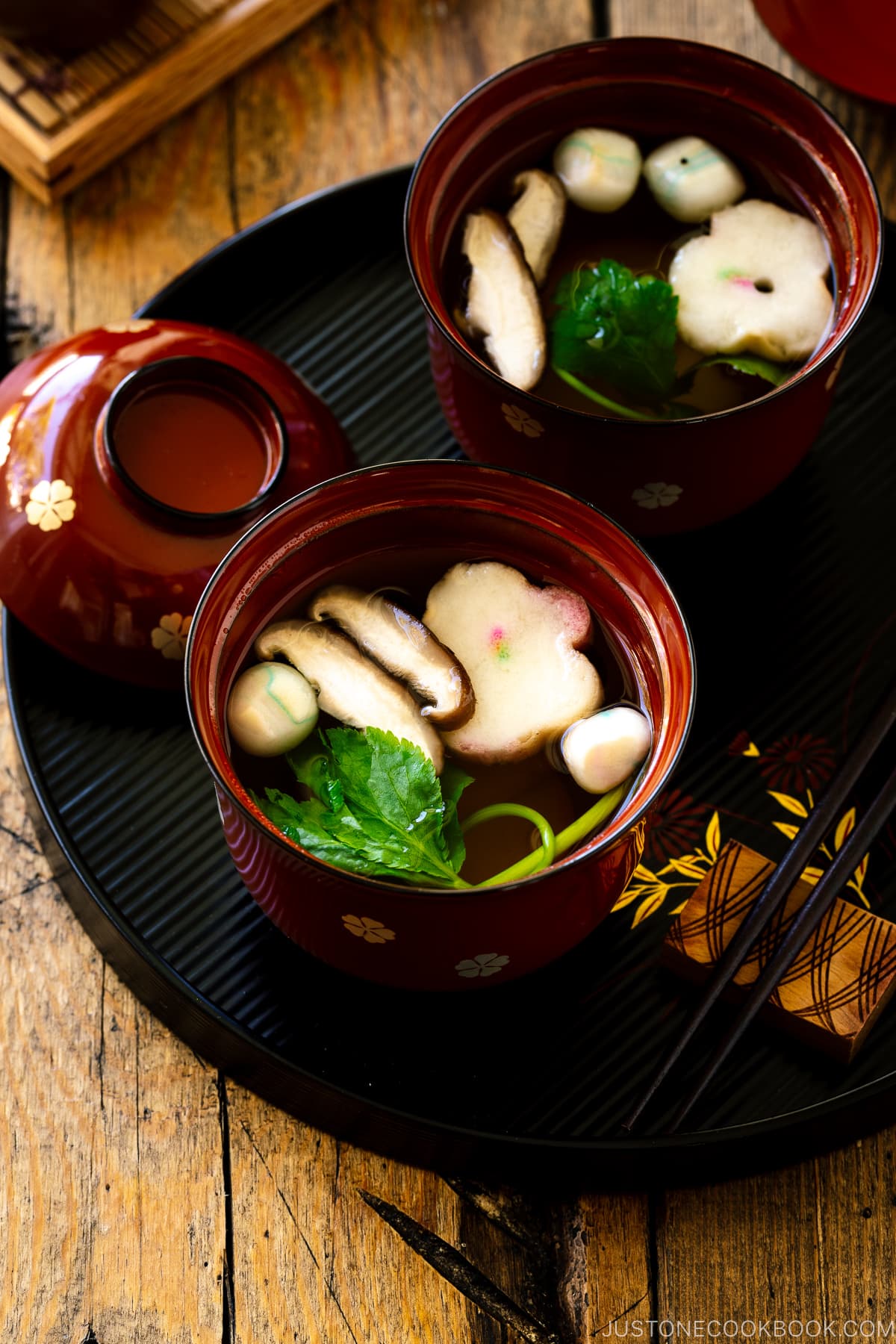
Seasonal Ingredients for Japanese Clear Soup
Here are some examples of seasonal vegetables that we can add to the clear soup.
- Spring: Nanohana (rape flower), snow peas, bamboo shoots, and cabbage.
- Summer: Myoga ginger, cucumber, eggplant, corn, and okra.
- Fall: Shimeji mushrooms, shiitake mushrooms, carrots, chrysanthemum leaves, sweet potatoes, napa cabbage, daikon, turnips, spinach, and gobo (burdock root)
- Winter: Yamaimo, lotus root, and komatsuna.
How to prepare:
The ingredients I used in today’s recipe do not require pre-cooking. If you want to add different ingredients to osumashi, be sure to first cook separately any ingredients that require cooking, then add them to the soup later. These include dense root vegetables or leafy greens that may release color, such as spinach. Once all the ingredients are cooked, simply add them to the clear soup to warm up.
What to Serve with Japanese Clear Soup
This simple yet elegant soup complements any ichiju sansai (one soup three dishes) and washoku-style meals. I would typically serve it with Takikomi Gohan (Japanese Mixed Rice) with seasonal ingredients, the main dish like Miso Cod or Salmon Kasuzukea pickled dish like Napa Cabbage Picklesand one or two vegetable sides such as Kinpira Gobo and Chrysanthemum Greens and Tofu Salad (Shungiku Shiraae).
Tableware from Musubi Kiln
I’ve partnered with a great ceramic online shop from Japan called Musubi Kiln. You will get 10% off with a coupon code JUSTICE BOOKBOOK for your purchase. In this post, I’ve used:
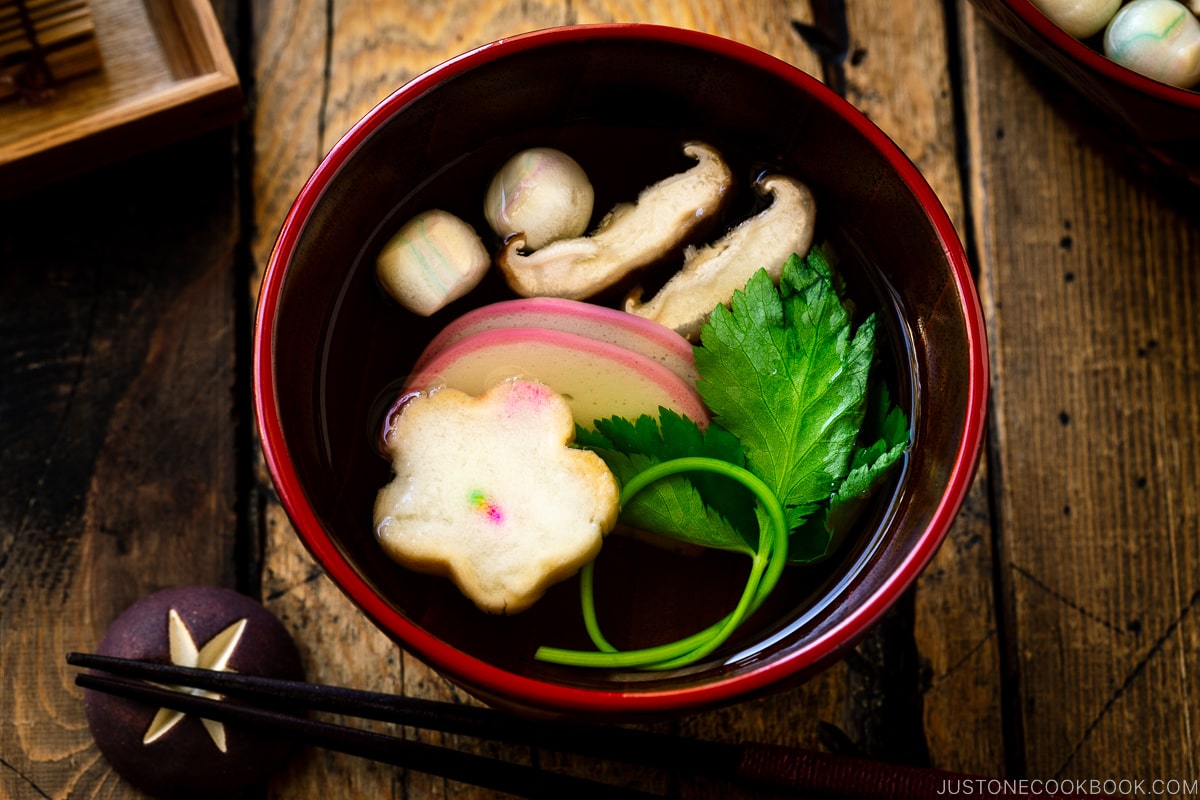
More Japanese Soups You’ll Enjoy
Wish to learn more about Japanese cooking? Sign up for our free newsletter to receive cooking tips & recipe updates! And stay in touch with me on Facebook, Pinterest, YouTubeand Instagram.
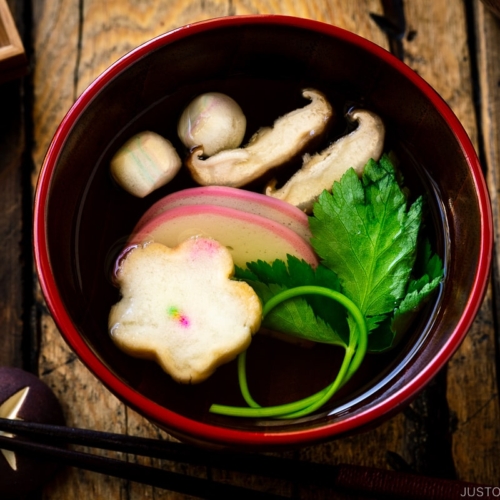
Japanese Clear Soup (Osumashi)
Japanese Clear Soup or Osumashi features a simple dashi-based broth lightly seasoned with soy sauce. With this elegant soup, you can easily switch up the colorful ingredients depending on what‘s in season. Here, I added kamaboko fish cake slices, mitsuba leaf, shiitake mushrooms, and flower-shaped fu (wheat gluten). The broth‘s deep, clean taste allows the seasonal flavors to shine through.
Ingredients
Prevent your screen from going dark
Instructions
To Make the Awase Dashi
-
Gather all the ingredients. Most Japanese recipes would say to gently clean the kombu with a damp cloth. However, these days, kombu is quite clean, so just make sure it doesn’t have any mold spots and it‘s ready to use. Do not wash or wipe off the white powdery substance, as it has lots of umami. Put the water and kombu in a large bottle or measuring cup and let it steep on the counter for at least 30 minutes (or ideally, 2–3 hours in the summertime and 4–5 hours in the wintertime). You can also cold brew the kombu dashi overnight in the refrigerator.
-
Add 1 piece kombu (dried kelp) and 4 cups water to a medium saucepan. If you have cold brew Kombu Dashi (previous step), add the Kombu Dashi and hydrated kombu to the pot.
-
Turn on the heat to medium low and slowly bring it to almost boilingabout 10 minutes. Just before the dashi starts boiling gently, remove the kombu from the pot (discard or repurpose it in other recipes—suggestions follow). If you leave the kombu in the pot, the dashi will become slimy and bitter.
-
Add 1 cup katsuobushi (dried bonito flakes) and bring it back to a boil again. Once the dashi is boiling, reduce the heat, simmer for just 30 seconds, and turn off the heat.
-
Let the katsuobushi sink to the bottom, for about 10 minutes. Meanwhile, you can prepare the soup ingredients.
-
Strain the dashi through a fine-mesh sieve over a bowl or measuring cup. The Awase Dashi is ready to use.
-
Reserve the spent kombu and katsuobushi in an airtight container and store it in the refrigerator for a week or in the freezer for up to a month. See the instructions below for how to repurpose them.
To Prepare the Ingredients
-
Tips: The ingredients I use here do not require pre-cooking. If you want to add different ingredients to Osumashibe sure to first cook separately any ingredients that require cooking, then add them to the soup later. These include dense root vegetables or leafy greens that may release color, such as spinach. Once all the ingredients are cooked, simply add them to the clear soup to warm up.
-
Soak 8 pieces fu (wheat gluten) in water for 10 minutes. Once soft, gently squeeze out the water.
-
Discard the stems of 2 shiitake mushrooms and thinly slice them about ¼ inch (6 mm) thick.
-
Make a knot in each of the stems of 4 sprigs mitsuba (Japanese parsley). Detach the wooden board of the kamaboko by sliding the knife under the fish cake. Then, thinly cut 8 slices kamaboko (fish cake) about ⅛ inch (3 mm) thick.
To Make the Soup
-
Divide and add the rehydrated wheat gluten and mitsuba to the individual bowls.
-
Next, make the clear soup broth. Add 3⅓ cups dashi (Japanese soup stock) back to the pot and season with 2 tsp usukuchi (light-colored) soy sauce and ½ tsp Diamond Crystal kosher salt.
-
Add the kamaboko fish cake slices and shiitake mushrooms to the pot and heat until warm. Serve the soup in the individual bowls.
-
Enjoy!
What To Do with the Spent Katsuobushi and Kombu?
Nutrition
Nutrition Facts
Japanese Clear Soup (Osumashi)
Amount per Serving
% Daily Value*
* Percent Daily Values are based on a 2000 calorie diet.
©JustOneCookbook.com Content and photographs are copyright protected. Sharing of this recipe is both encouraged and appreciated. Copying and/or pasting full recipes to any website or social media is strictly prohibited. Please view my photo use policy here.

